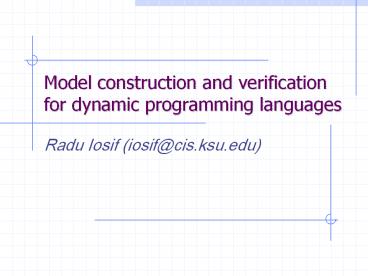Model%20construction%20and%20verification%20for%20dynamic%20programming%20languages - PowerPoint PPT Presentation
Title:
Model%20construction%20and%20verification%20for%20dynamic%20programming%20languages
Description:
canonical symmetry reductions for heap. model checking algorithm that combines heap with process symmetry ... Add support for handling heap abstractions ... – PowerPoint PPT presentation
Number of Views:29
Avg rating:3.0/5.0
Title: Model%20construction%20and%20verification%20for%20dynamic%20programming%20languages
1
Model construction and verification for dynamic
programming languages
- Radu Iosif (iosif_at_cis.ksu.edu)
2
Outline
- Semantics of dynamic programs
- Extensions to the BIR language
- The dSPIN model checker
- Symmetry and Partial Order reductions
- Abstractions for dynamic languages
3
Semantics
- In a dynamic program the number of state
components changes constantly along an execution
path - Configurations are described by means of partial
mappings - Transitions define also how components are
added/removed from configurations
4
Domains and operations (exp)
Store Variables ?Values? Heap (Locations ?
Store?) X Locations Thread Control X
Store Pool (ThreadId ? Thread?) X
ThreadId State Store X Heap X Pool
new Heap? Heap X Locations start Pool ? Pool
X ThreadId
5
Bandera IR
- A dynamic guarded commands language (invented by
James Corbett) - Operational semantics definition
- led to the discovery of a number of
inconsistencies, e.g. in the runtime type system - Extended to handle dynamic threads in addition to
heap objects
6
Future plans for BIR/back-end
- Recursive functions and polymorphism
- Exceptions
- issues related to the observation of exceptional
events by a property - Build a dSPIN target
7
dSPIN dynamic SPIN
- Extension of the SPIN model checker with support
for - pointers
- dynamic creation of objects
- recursive functions and polymorphic calls
- garbage collection
- www.cis.ksu.edu/iosif/dspin
8
dSPIN (cont.)
- Adding dynamic features to the input languages
causes the state space to blow up - On-the-fly reductions
- canonical symmetry reductions for heap
- model checking algorithm that combines heap with
process symmetry - use of partial order reductions in combination
with heap symmetry
9
Symmetry and PO reduction
- Basic idea heap objects can be ordered (strictly
and totally) based on their reachability chains - Combining heap with process symmetry uses the
idea of path unwinding - This strategy makes symmetry reductions
compatible with fairness - Better PO reduction by extending the notion of
independence to allocators
10
Future plans for dSPIN
- Define the semantics of and implement imprecise
exceptions - Add support for handling heap abstractions
- Use of pointer and escape analysis to further
improve partial order reduction
11
Abstractions for dynamic languages
- Heap abstractions (shape graphs)
- investigate the use of program transformation vs.
on-the-fly parametric techniques - refinement of abstractions
- what kind of predicates should be added?
- how can the property guide the refinement?
- how can we use counterexamples?
- Other abstractions threads, locks, stack































